
Boat under sail in Fishing Bay
We finally threw off the docklines for more than a short sail, and headed up to Deltaville for some boat work. Unfortunately, Hurricane Earl was on the move as well, and he interrupted our plans a bit, which turned out to be his only effect on us. We’re not done with Hampton yet, but our time remaining is getting short.
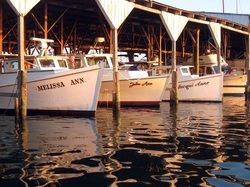
Calm times in Deltaville before Earl
EARL-y Out
We had been watching the tropical storms start forming one after another off Africa and knew it was only a matter of time before we had to deal with one coming close to us. Danielle was the first threat, but she decided to stay well offshore. But Earl was starting to look suspicious. The boatyard began to buzz with discussions about the storm. Was it a threat or not?
Orion was docked in the boatyard’s service slip next to the TravelLift. As Tuesday morning arrived, we awoke to the sound of the crane moving and began to watch a procession of boats being hauled and transported into the yard. Needless to say, this got our attention. Dave went off to consult with other cruisers and the boatyard about alternatives for weathering the storm, while Cathy made preparations on the boat. The remaining enclosure panels would need to come down. Before doing so, Cathy cleaned and polished them. If we were going to be at anchor for several days, we would need some more groceries and would need to do laundry. We also needed gas for the generator and the dinghy.
When Dave returned, he had our options laid out. Larry on The Dove, Larry and Lynn on Two Morrows, and Michael on Wind in the Willows were on the hard in the boatyard, and had various experiences to share, having weathered storms nearby before. The boatyard management also had their experience and recommendations.
It boiled down to this. We could haul the boat, stay where we were, or move to find hurricane protection.
We didn’t think staying put had much appeal. Any storm surge would put our dock well under water. Getting hauled would be the safest alternative, but we knew that once we came out, we wouldn’t go back in for a couple of months. To hedge our bets, Dave had already placed our name on the haulout list. We could take it off if wanted, but it was already too late to choose to add it. Once hauled, we would need to shift our attention to take advantage of time on the hard, doing boat projects that can only be done with the boat out of the water. Having been hauled each of the last 2 years though, we were really hoping to skip the haul-out this year. That left moving to a safer place. In our discussions over the last 2 days, a local hurricane hole kept coming up – Wilton Creek. It is about 10 miles further up the Piankatank from Jackson Creek, where Deltaville Boatyard is located. Dave looked it up on a chart and plotted a route there. It looked like there would be plenty of protection and enough room to anchor comfortably, as long as not too many other boats had the same idea.
But what about the storm? How bad was it going to be? We kept watching the updates from NOAA and the weather channel. It was hard to tell what surge there would be, but the winds did not seem too bad. At worst, gusting to 45 knots. We felt we could weather that easily in a protected anchorage. So, we finally decided that we would take our chances in the water, and move to Wilton Creek. To ensure we still had options if we got there and didn’t like it, we decided to head over Tuesday afternoon. If we liked it, we would simply stay through the storm. By 3:30pm, the laundry was done, and Dave was back from running some errands in town and getting gas. We were ready to head out. With no wind to sail to, we simply motored our way up the Piankatank, following its twists and turns until we neared the Rt 3 bridge, where we hung a right to follow the stakes marking the entrance to Wilton Creek.
We had been watching the tropical storms start forming one after another off Africa and knew it was only a matter of time before we had to deal with one coming close to us. Danielle was the first threat, but she decided to stay well offshore. But Earl was starting to look suspicious. The boatyard began to buzz with discussions about the storm. Was it a threat or not?
Orion was docked in the boatyard’s service slip next to the TravelLift. As Tuesday morning arrived, we awoke to the sound of the crane moving and began to watch a procession of boats being hauled and transported into the yard. Needless to say, this got our attention. Dave went off to consult with other cruisers and the boatyard about alternatives for weathering the storm, while Cathy made preparations on the boat. The remaining enclosure panels would need to come down. Before doing so, Cathy cleaned and polished them. If we were going to be at anchor for several days, we would need some more groceries and would need to do laundry. We also needed gas for the generator and the dinghy.
When Dave returned, he had our options laid out. Larry on The Dove, Larry and Lynn on Two Morrows, and Michael on Wind in the Willows were on the hard in the boatyard, and had various experiences to share, having weathered storms nearby before. The boatyard management also had their experience and recommendations.
It boiled down to this. We could haul the boat, stay where we were, or move to find hurricane protection.
We didn’t think staying put had much appeal. Any storm surge would put our dock well under water. Getting hauled would be the safest alternative, but we knew that once we came out, we wouldn’t go back in for a couple of months. To hedge our bets, Dave had already placed our name on the haulout list. We could take it off if wanted, but it was already too late to choose to add it. Once hauled, we would need to shift our attention to take advantage of time on the hard, doing boat projects that can only be done with the boat out of the water. Having been hauled each of the last 2 years though, we were really hoping to skip the haul-out this year. That left moving to a safer place. In our discussions over the last 2 days, a local hurricane hole kept coming up – Wilton Creek. It is about 10 miles further up the Piankatank from Jackson Creek, where Deltaville Boatyard is located. Dave looked it up on a chart and plotted a route there. It looked like there would be plenty of protection and enough room to anchor comfortably, as long as not too many other boats had the same idea.
But what about the storm? How bad was it going to be? We kept watching the updates from NOAA and the weather channel. It was hard to tell what surge there would be, but the winds did not seem too bad. At worst, gusting to 45 knots. We felt we could weather that easily in a protected anchorage. So, we finally decided that we would take our chances in the water, and move to Wilton Creek. To ensure we still had options if we got there and didn’t like it, we decided to head over Tuesday afternoon. If we liked it, we would simply stay through the storm. By 3:30pm, the laundry was done, and Dave was back from running some errands in town and getting gas. We were ready to head out. With no wind to sail to, we simply motored our way up the Piankatank, following its twists and turns until we neared the Rt 3 bridge, where we hung a right to follow the stakes marking the entrance to Wilton Creek.

The lone anchored boat in Wilton Creek
At the second bend, we saw the first and only boat anchored in the creek. As the creek opened up toward the north, there were high banks, topped with tall trees surrounding us on all sides. We chose a spot to anchor around the 2nd bend in 7-8 feet of water at low tide. The anchor set well, and we had 2 days for it to dig in well before the storm. We would spend Wednesday continuing our preparations for the storm. Cathy stowed the enclosure, while Dave got the generator going for the first time in 5 months. We launched the dinghy, with plans to explore the creek, as well as making sure it was available in the unlikely event we needed to get off the boat. However, the dinghy motor didn’t start as easily as the generator. The gas that was sitting in it from the Bahamas did not age well, even though it was ethanol free. We needed to empty the tank and then get new gas. But in our haste to leave, we didn’t have enough gas to mix a fresh batch for the dinghy motor.

Andy visits us from shore
We were in luck however. We had been anchored only an hour or so before we met Helen and Andy, who were checking out the creek from their home on the Piankatank. They were assessing whether they needed to move their sailboat back into the protection of Wilton Creek. We chatted about the prospects for the storm, and agreed to check in the next day. We offered to help them move their boat, and they offered to help us if we needed anything. When they arrived the next day, they agreed to fill our gas tank for the dinghy. Dave proceeded to drain the dinghy motor and fill it with the new gas. However, he still wasn’t in the clear, since he discovered the fuel cut-off was stuck in the closed position. Luckily, he had had an outlet added to enable connection to an external fuel tank. He used this connection and managed to re-plumb the fuel line. With that change, the dinghy motor started up and stayed running. We were in business.

Helen and Andy's home on the Piankatank
We used the dinghy to visit Helen and Andy to thank them for their help. Their home on the Piankatank had a beautiful view of the river. As we returned to the boat, we met the first of a few anchored neighbors. Hampton Rose had arrived after a trip up from Little Creek, near Virginia Beach. They were to be joined the next day, Thursday, by 5 more boats. Meanwhile the owners of the boats docked nearby were busy adding lines. Dave dinghyed over to help attach the lines to the outer pilings. He even tried to help deploy an anchor for a trawler, but the weight of the anchor and chain overwhelmed our little dinghy. As a way of saying thanks, we were invited to the dock for a pre-storm party, and got to meet many of the boat owners who lived in the complex nearby, as well as some of our anchored neighbors.
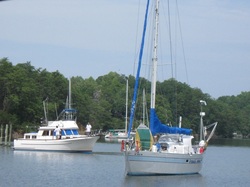
Boats anchoring Wilton Creek
After such a big hype, though, Earl was a bit of a letdown. He brought some much-needed rain, along with wind and cooler temperatures that were a relief from the sweltering heat of the days preceding. But there was no surge, and the winds barely exceeded 10 knots. We used the rainwater to help clean the deck, which was the least cluttered it had been in a year. By early afternoon, the rain had stopped and the sun began to appear. We stayed in the creek until mid-day on Saturday, using the time to put Orion back together and to take some time to explore the creek by dinghy. Overall, we were glad we had dodged this bullet.
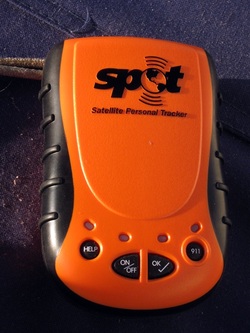
SPOT Personal Tracker
Spotting Orion
We have added a new capability for tracking Orion’s movements, with our recent purchase of a SPOT Personal Tracker device. It communicates our position via satellite. We can either choose to manually send our position at regular intervals or have it automatically send a position. We are currently manually sending the position every time we do a log entry, which is once an hour while we are underway. We have configured our website to show these position updates on a new Location page. It makes it easier for family and friends to understand where we are, especially in our more remote travels.
The device also has a “Help” and a “911” feature. If we press the “Help” button, an e-mail with our position will be sent to our emergency contacts. If we press the “911” button, the Spot Control Center will be notified. They will attempt to verify the call by contacting our emergency contacts, and then activate the emergency response unit applicable to our location, normally the Coast Guard. We hope to never need this feature, but it is good to have more redundancy for distress calls in the event of an emergency.
We have added a new capability for tracking Orion’s movements, with our recent purchase of a SPOT Personal Tracker device. It communicates our position via satellite. We can either choose to manually send our position at regular intervals or have it automatically send a position. We are currently manually sending the position every time we do a log entry, which is once an hour while we are underway. We have configured our website to show these position updates on a new Location page. It makes it easier for family and friends to understand where we are, especially in our more remote travels.
The device also has a “Help” and a “911” feature. If we press the “Help” button, an e-mail with our position will be sent to our emergency contacts. If we press the “911” button, the Spot Control Center will be notified. They will attempt to verify the call by contacting our emergency contacts, and then activate the emergency response unit applicable to our location, normally the Coast Guard. We hope to never need this feature, but it is good to have more redundancy for distress calls in the event of an emergency.
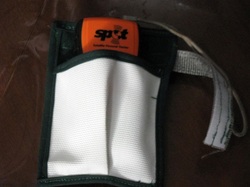
New cockpit pocket for the SPOT
Boat Stuff
- Despite our early departure from Deltaville, Cathy was able to use her time there to make another pocket to house our new Spot device in the cockpit.
- We were disappointed when on our first trip up the Bay, we turned on our AIS only to find out we were receiving no signals. Once we arrived in Deltaville, Dave discovered the problem was simply a loose wire that he had forgotten to permanently attach. Once he secured the wire, the signals started appearing again.
- After a brief trip out on Orion before leaving for Deltaville, we discovered that the growth on Orion’s bottom and running gear were affecting her performance, losing us up to a knot of speed. We had a diver come to clean the bottom and change the zinc before we left, which should be good enough to keep her running through October.
- Despite our early departure from Deltaville, Cathy was able to use her time there to make another pocket to house our new Spot device in the cockpit.
- We were disappointed when on our first trip up the Bay, we turned on our AIS only to find out we were receiving no signals. Once we arrived in Deltaville, Dave discovered the problem was simply a loose wire that he had forgotten to permanently attach. Once he secured the wire, the signals started appearing again.
- After a brief trip out on Orion before leaving for Deltaville, we discovered that the growth on Orion’s bottom and running gear were affecting her performance, losing us up to a knot of speed. We had a diver come to clean the bottom and change the zinc before we left, which should be good enough to keep her running through October.

Sue and crew aboard Daisy Sue
Daisy Sue sets sail
We have been helping our friend, Sue, get her boat ready to take out of the slip under its own power. This involved getting her engine impeller changed, and getting the safety systems and gear ready to pass inspection. Her navigation lights needed work, some of which was just cleaning corroded connections. A more significant project was wiring her steaming light, which was mounted, but had not been connected to a power source. We helped her climb the mast for the first time to check the bulb, and then Dave helped her trace the wiring back to the panel and re-connect it to a breaker. With just minutes to spare before the Coast Guard Auxillary inspector arrived, she completed the repairs, passed the inspection and received her sticker. A few days later, we joined her as she took Daisy Sue out for the first time on a sail, marking a milestone for both Sue and the boat.
We have been helping our friend, Sue, get her boat ready to take out of the slip under its own power. This involved getting her engine impeller changed, and getting the safety systems and gear ready to pass inspection. Her navigation lights needed work, some of which was just cleaning corroded connections. A more significant project was wiring her steaming light, which was mounted, but had not been connected to a power source. We helped her climb the mast for the first time to check the bulb, and then Dave helped her trace the wiring back to the panel and re-connect it to a breaker. With just minutes to spare before the Coast Guard Auxillary inspector arrived, she completed the repairs, passed the inspection and received her sticker. A few days later, we joined her as she took Daisy Sue out for the first time on a sail, marking a milestone for both Sue and the boat.

Bonnie and Troy by cave exhibit at VLM
Family and Friends
We were treated to one more visit from our daughter’s family, when they came to see the Virginia Living Museum and take a fishing trip out on the bay, before school began again. There were 2 more dock parties as well, celebrating summer’s end and our neighbor’s 60th birthday. .
We were treated to one more visit from our daughter’s family, when they came to see the Virginia Living Museum and take a fishing trip out on the bay, before school began again. There were 2 more dock parties as well, celebrating summer’s end and our neighbor’s 60th birthday. .
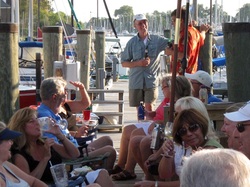
Woody's 60th birthday party
We plan to stay in Hampton for the big Bay Days festival this weekend, and then move on north, as we start the final preparations for the trip south in October.
